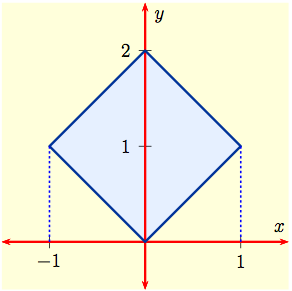Main page
Chapter 10: Parametric Equations and Polar Coordinates
Chapter 12: Vectors and the Geometry of Space
Chapter 13: Vector Functions
Chapter 14: Partial Derivatives
Chapter 15: Multiple Integrals
Learning module LM 15.1: Multiple integrals
Learning module LM 15.2: Multiple integrals over rectangles:
Learning module LM 15.3: Double integrals over general regions:
Learning module LM 15.4: Double integrals in polar coordinates:
Learning module LM 15.5a: Multiple integrals in physics:
Learning module LM 15.5b: Integrals in probability and statistics:
Learning module LM 15.10: Change of variables:
Change of variable in 1 dimensionMappings in 2 dimensions
Jacobians
Examples
Cylindrical and spherical coordinates
Examples
The following video demonstrates ways to use the change-of-variable formula to simplify integrals. In it, we compute the integral of $e^{x+2y}$ over a parallelogram, and the integral of $x^2$ over an off-center ellipse.
Example 1: Let's illustrate this change of variable idea in the case of polar coordinates. The Astrodome in Houston as shown to the right below might be modelled mathematically as the region below the cap of a sphere
| $$ x^2+y^2+z^2 \ = \ R^2$$ above a circular disk $$ D = \{(x,\,y) : x^2 + y^2 \le a^2\}\,.$$ In terms of double integrals its $$ \hbox{Volume} \ = \ \int\int_D\, \sqrt{R^2 - x^2 - y^2}\, dx dy\,.$$ Rotational symmetry suggests changing to polar coordinates! |
|
| Solution: In polar coordinates, $$D \ = \ \bigl\{ (r,\, \theta) : 0 \le r \le a\,, \ 0 \le \theta \le 2 \pi\,\bigl\}$$ is a rectangle, while $$\sqrt{R^2 - x^2 - y^2} \ = \ \sqrt{R^2 - r^2(\cos^2 \theta +\sin^2 \theta)} \,.$$ So after changing to polar coordinates, $$ I\ = \ \int_0^a\Bigl(\,\int_0^{2 \pi}\, \sqrt{R^2 - r^2}\ d\theta \Bigr)\, r dr\,.$$ | The presence of the Jacobian (here the $r$-factor) makes this an easy repeated integral using the substitution $u = r^2$. For then $$I = \pi \int_0^a\, \sqrt{R^2 - u}\, du= \frac{2\pi}{3}\Bigl[\, -(R^2 - u)^{3/2}\,\Bigl]_0^a\,.$$ Consequently, the mathematical Astrodome has $$ \hbox{Volume}\ = \ \frac{2\pi}{3}\Bigl(\, R^{3} - (R^2 - a^2)^{3/2}\Bigr)\, .$$ |
The Astrodome problem showed how this works when ${\bf \Phi}$ is the change of coordinates from polar to Cartesian coordinates, but matrix mappings often help too. They usually come in two 'flavors' as indicated in
| Example 2a: Use the transformation $${\bf \Phi} : (u,\, v) \ \longrightarrow \ \bigl(\,x(u,\, v),\ y(u,\, v)\, \bigr)$$ with $$x \ = \ \frac{1}{2}\bigl(u-v\bigl) \,, \quad y \ = \ \frac{1}{2}\bigl(u+v\bigl) $$ to evaluate the integral $$ I \ = \ \int\int_D\ (x+y) \, dx dy$$ when $D$ is the square shown to the right. |
|
| Example 2b: Use an appropriate transformation $${\bf \Phi} : (u,\, v) \ \longrightarrow \ \bigl(\,x(u,\, v),\ y(u,\, v)\, \bigr)$$ to evaluate the integral $$ I \ = \ \int\int_D\ (x+y) \, dx dy$$ when $D$ is the square having corner points $$(0,\,0)\,, \ \ (1,\, 1)\,, \ \ (0,\, 2)\,, \ \ (-1,\, 1)\,.$$ as shown to the right. |
|
Solving 2a should be easier than 2b because we are already given the transformation, but both cases are very similar in the sense that we'll end up solving a pair of simultaneous equations.
| Solution for Example 2a: When $$x \ = \ \frac{1}{2}\bigl(u-v\bigl) \,, \quad y \ = \ \frac{1}{2}\bigl(u+v\bigl) $$ the Jacobian of the transformation $${\bf \Phi} : (u,\, v) \ \longrightarrow \ \bigl(\,x(u,\, v),\ y(u,\, v)\, \bigr)$$ is given by $$\frac{\partial (x,\,y)}{\partial (u,\,v)} \ = \ \left|\begin{matrix} \displaystyle {\frac{1}{2}}& \displaystyle{-\frac{1}{2}}\cr \\ \displaystyle {\frac{1}{2}}& \displaystyle { \frac{1}{2}}\end{matrix}\right|\ = \ \frac{1}{2}\,.$$ On the other hand, $$x+y \ = \ \frac{1}{2}\bigl(u-v\bigl) + \frac{1}{2}\bigl(u+v\bigl)\ = \ u\,.$$ So if ${\bf \Phi}$ maps $D^*$ onto $D$, then $$I \ = \ \frac{1}{2}\int_a^b\int_c^d\ u\ du dv\,.$$ | It remains to find $a,\, b,\, c,\,d$ knowing that $${\bf \Phi}(a,\,c)\,=\, (0,\,0)\,, \quad {\bf \Phi}(b,\,c)\,=\, (1,\,1)$$ $${\bf \Phi}(b,\,d)\,=\, (0,\,2)\,, \quad {\bf \Phi}(a,\,d)\,=\, (-1,\,1)$$ But $x,\, y$ is given in terms of $u,\, v$: $$2x \ = \ u-v \,, \quad 2y \ = \ u+v\,, $$ so we need to solve for $u,\,v$: $$u\ = \ x+y \,, \qquad v\ = \ y-x\,.$$ This shows that $$a \,=\, c\,=\, 0, \quad b\,=\, 2, \quad d\,=\, 2\,,$$ Consequently, $$I \ = \ \frac{1}{2}\int_0^2\int_0^2\ u\, dudv\ = \ 2\, .$$ |
| Solution for Example 2b: Since we know the corners of $D$, we can use the point slope formula to express $D$ as the square enclosed by the pairs of parallel lines $$y=x,\ \ y= x+2, \quad y=-x,\ \ y=-x +2\,.$$ Thus $D$ is the region $$\big\{ (x,\,y) : 0 \le x+y \le 2,\ \ 0 \le y -x \le 2\big\}$$ in the $xy$-plane. This suggests setting $$ u \,=\, x+y,\quad v\,=\, y-x\,,$$ $$ D^* \ = \ \big\{ (u,\,v) : 0\le u \le 2,\ 0 \le v \le 2\big\}\,.$$ | To determine $${\bf \Phi} : (u,\, v) \to (x(u,\,v),\, v(u,\, v))$$ we need to express $x,\, y$ in terms of $u,\, v$. Solve for $x,\,y$ in the earlier linear equations: $$x \ = \ \frac{1}{2}\bigl(u-v\bigl) \,, \quad y \ = \ \frac{1}{2}\bigl(u+v\bigl) \,.$$ Consequently, after calculating the Jacobian as before we get $$I \ = \ \frac{1}{2}\int_0^2\int_0^2\ u\, dudv\ = \ 2\, .$$ |

